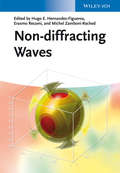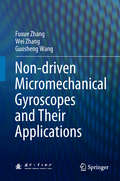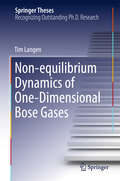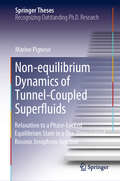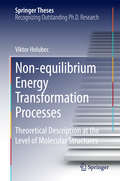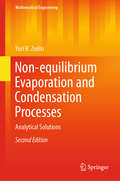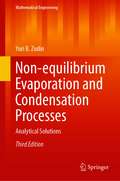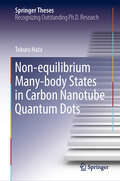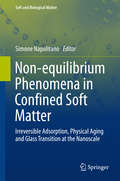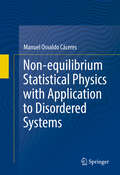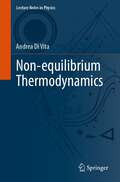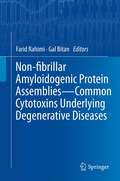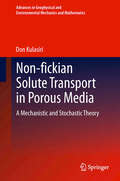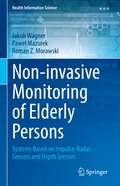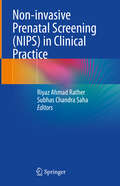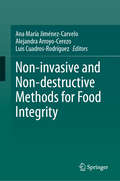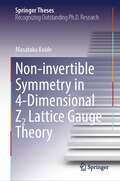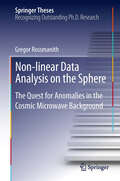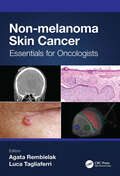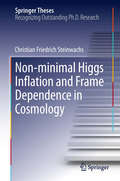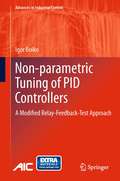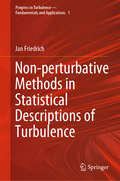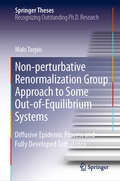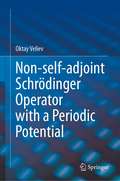- Table View
- List View
Non-diffracting Waves
by Erasmo Recami Hugo E. Hernández-Figueroa Michel Zamboni-RachedThis continuation and extension of the successful book "Localized Waves" by the same editors brings together leading researchers in non-diffractive waves to cover the most important results in their field and as such is the first to present the current state.The well-balanced presentation of theory and experiments guides readers through the background of different types of non-diffractive waves, their generation, propagation, and possible applications. The authors include a historical account of the development of the field, and cover different types of non-diffractive waves, including Airy waves and realistic, finite-energy solutions suitable for experimental realization. Apart from basic research, the concepts explained here have promising applications in a wide range of technologies, from wireless communication to acoustics and bio-medical imaging.
Non-driven Micromechanical Gyroscopes and Their Applications
by Wei Zhang Fuxue Zhang Guosheng WangThis book comprehensively and systematically introduces readers to the theories, structures, performance and applications of non-driven mechanical and non-driven micromechanical gyroscopes. The book is divided into three parts, the first of which mainly addresses mathematic models, precision, performance and operating error in non-driven mechanical gyroscopes. The second part focuses on the operating theory, error, phase shift and performance experiments involving non-driven micromechanical gyroscopes in rotating flight carriers, while the third part shares insights into the application of non-driven micromechanical gyroscopes in control systems for rotating flight carriers. The book offers a unique resource for all researchers and engineers who are interested in the use of inertial devices and automatic control systems for rotating flight carriers. It can also serve as a reference book for undergraduates, graduates and instructors in related fields at colleges and universities.
Non-equilibrium Dynamics of One-Dimensional Bose Gases
by Tim LangenThis work presents a series of experiments with ultracold one-dimensional Bose gases, which establish said gases as an ideal model system for exploring a wide range of non-equilibrium phenomena. With the help of newly developed tools, like full distributions functions and phase correlation functions, the book reveals the emergence of thermal-like transient states, the light-cone-like emergence of thermal correlations and the observation of generalized thermodynamic ensembles. This points to a natural emergence of classical statistical properties from the microscopic unitary quantum evolution, and lays the groundwork for a universal framework of non-equilibrium physics. The thesis investigates a central question that is highly contested in quantum physics: how and to which extent does an isolated quantum many-body system relax? This question arises in many diverse areas of physics, and many of the open problems appear at vastly different energy, time and length scales, ranging from high-energy physics and cosmology to condensed matter and quantum information. A key challenge in attempting to answer this question is the scarcity of quantum many-body systems that are both well isolated from the environment and accessible for experimental study.
Non-equilibrium Dynamics of Tunnel-Coupled Superfluids: Relaxation to a Phase-Locked Equilibrium State in a One-Dimensional Bosonic Josephson Junction (Springer Theses)
by Marine PigneurThe relaxation of isolated quantum many-body systems is a major unsolved problem of modern physics, which is connected to many fundamental questions. However, realizations of quantum many-body systems which are both well isolated from their environment and accessible to experimental study are scarce. In recent years, the field has experienced rapid progress, partly attributed to ultra-cold atoms. This book presents the experimental study of a relaxation phenomenon occurring in a one-dimensional bosonic Josephson junction. The system consists of two 1D quasi Bose-Einstein condensates of 87Rb, magnetically trapped on an atom chip. Using radio-frequency dressing, the author deforms a single harmonic trap, in which the atoms are initially condensed, into a double-well potential and realizes a splitting of the wave function. A large spatial separation and a tilt of the double-well enable the preparation of a broad variety of initial states by precisely adjusting the initial population and relative phase of the two wave packets, while preserving the phase coherence. By re-coupling the two wave packets, the author investigates tunneling regimes such as Josephson (plasma) oscillations and macroscopic quantum self-trapping. In both regimes, the tunneling dynamics exhibits a relaxation to a phase-locked equilibrium state contradicting theoretical predictions. The experimental results are supported with an empirical model that allows quantitative discussions according to various experimental parameters. These results illustrate how strongly the non-equilibrium dynamics differ from the equilibrium one, which is well described by thermodynamics and statistical physics.
Non-equilibrium Energy Transformation Processes
by Viktor HolubecVarious experimental techniques have been advanced in recent years to measure non-equilibrium energy transformations on the microscopic scale of single molecules. In general, the systems studied in the corresponding experiments are exposed to strong thermal fluctuations and thus the relevant energetic variables such as work and heat become stochastic. This thesis addresses challenging theoretical problems in this active field of current research: 1) Exact analytical solutions of work and heat distributions for isothermal non-equilibrium processes in suitable models are obtained; 2) Corresponding solutions for cyclic processes involving two different heat reservoirs are found; 3) Optimization of periodic driving protocols for such cyclic processes with respect to maximal output power, efficiency and minimal power fluctuations is studied. The exact solutions for work and heat distributions provide a reference for theoretical investigations of more complicated models, giving insight into the structure of the tail of work distributions and serving as valuable test cases for simulations of the underlying stochastic processes.
Non-equilibrium Evaporation and Condensation Processes: Analytical Solutions (Mathematical Engineering)
by Yuri B. ZudinThis monograph is focused mostly on the exposition of analytical methods for the solution of problems of strong phase change. A new theoretical model is proved useful in describing, with acceptable accuracy, problems of strong evaporation and condensation. The book is the first to treat the problem of asymmetry for evaporation/condensation. A semi-empirical model for the process is proposed for purposes of practical calculation of the process of strong evaporation. The “limiting schemes” of the vapor bubble growth are analyzed. The thermo-hydrodynamic problem of evaporating meniscus of a thin liquid film on a heated surface is considered. A theoretical analysis of the problem of evaporation of a drop levitating over a vapor cushion is performed. The problem of vapor condensation upon a transversal flow around a horizontal cylinder is considered. The second edition is extended by (i) the conjugate “strong evaporation - heat conduction” problem, (ii) the influence of accommodation coefficients on intensive processes of evaporation and condensation, (iii) the problem of supersonic condensation. This book is the first to present a comprehensive theoretical approach of boiling problems: nucleate boiling, superfluid helium phase transition, similarity between pseudo-boiling and subcritical pressure nucleate boiling. The target audience primarily comprises research experts in the field of thermodynamics and fluid dynamics, but the book may also be beneficial for graduate students.
Non-equilibrium Evaporation and Condensation Processes: Analytical Solutions (Mathematical Engineering)
by Yuri B. ZudinThis present book is concerned with analytical approaches to statement and solution of problems of non-equilibrium evaporation and condensation. From analytical solutions, one is capable to understand and represent in a transparent form the principal laws, especially in the study of a new phenomenon or a process. This is why analytical methods are always employed on the first stage of mathematical modeling. Analytical solutions are also used as test models for validation of results numerical solutions. Non-equilibrium evaporation and condensation processes play an important role in a number of fundamental and applied problems: laser methods for processing of materials, depressurization of the protection cover of nuclear propulsion units, solar radiation on a comet surface, explosive boiling of superheated liquid, thermodynamic principles of superfluid helium. Analytical relations provide an adequate description of the essence of a physical phenomenon.
Non-equilibrium Many-body States in Carbon Nanotube Quantum Dots (Springer Theses)
by Tokuro HataThis book presents the first experiment revealing several unexplored non-equilibrium properties of quantum many-body states, and addresses the interplay between the Kondo effect and superconductivity by probing shot noise. In addition, it describes in detail nano-fabrication techniques for carbon nanotube quantum dots, and a measurement protocol and principle that probes both equilibrium and non-equilibrium quantum states of electrons. The book offers various reviews of topics in mesoscopic systems: shot noise measurement, carbon nanotube quantum dots, the Kondo effect in quantum dots, and quantum dots with superconducting leads, which are relevant to probing non-equilibrium physics. These reviews offer particularly valuable resources for readers interested in non-equilibrium physics in mesoscopic systems. Further, the cutting-edge experimental results presented will allow reader to catch up on a vital new trend in the field.
Non-equilibrium Phenomena in Confined Soft Matter
by Simone NapolitanoThis book deals with those properties of non-equilibrium soft matter that deviate greatly from the bulk properties as a result of nanoscale confinement. The ultimate physical origin of these confinement effects is not yet fully understood. At the state of the art, the discussion on confinement effects focuses on equilibrium properties, finite size effects and interfacial interactions. However this is a limited vision which does not fully capture the peculiar behaviour of soft matter under confinement and some exotic phenomena that are displayed. This volume will be organized in the following three main themes. Equilibration and physical aging: treating non-equilibrium via the formal methodology of statistical physics in bulk, we analyse physical origin of the non-equilibrium character of thin polymer. We then focus on the impact of nanoconfinement on the equilibration of glasses of soft matter (a process of tremendous technological interest, commonly known as physical aging), comparing the latest trends of polymers in experiments, simulations with those of low-molecular weight glass formers. Irreversible adsorption: the formation of stable adsorbed layers occurs at timescales much larger than the time necessary to equilibrate soft matter in bulk. Recent experimental evidence show a strong correlation between the behaviour of polymers under confinement and the presence of a layer irreversibly adsorbed onto the substrate. This correlation hints at the possibility to tailor the properties of ultrathin films by controlling the adsorption kinetics. The book reports physical aspects of irreversible chain adsorption, such as the dynamics, structure, morphology, and crystallization of adsorbed layers. Glass transition and material properties: this section of the book focuses on the spread of absolute values in materials properties of confined systems, when measured by different experimental and computation techniques and a new method to quantify the effects of confinement in thin films and nanocomposites independently on the investigation procedure will be presented.
Non-equilibrium Statistical Physics with Application to Disordered Systems
by Manuel Osvaldo CáceresThis textbook is the result of the enhancement of several courses on non-equilibrium statistics, stochastic processes, stochastic differential equations, anomalous diffusion and disorder. The target audience includes students of physics, mathematics, biology, chemistry, and engineering at undergraduate and graduate level with a grasp of the basic elements of mathematics and physics of the fourth year of a typical undergraduate course. The little-known physical and mathematical concepts are described in sections and specific exercises throughout the text, as well as in appendices. Physical-mathematical motivation is the main driving force for the development of this text. It presents the academic topics of probability theory and stochastic processes as well as new educational aspects in the presentation of non-equilibrium statistical theory and stochastic differential equations.. In particular it discusses the problem of irreversibility in that context and the dynamics of Fokker-Planck. An introduction on fluctuations around metastable and unstable points are given. It also describes relaxation theory of non-stationary Markov periodic in time systems. The theory of finite and infinite transport in disordered networks, with a discussion of the issue of anomalous diffusion is introduced. Further, it provides the basis for establishing the relationship between quantum aspects of the theory of linear response and the calculation of diffusion coefficients in amorphous systems.
Non-equilibrium Thermodynamics (Lecture Notes in Physics #1007)
by Andrea Di VitaThe importance of thermodynamics, particularly its Second Principle, to all branches of science in which systems with very large numbers of particles are involved cannot be overstated. This book offers a panoramic view of non-equilibrium thermodynamics. Perhaps the two most attractive aspects of thermodynamic equilibrium are its stability and its independence from the specifics of the particular system involved. Does an equivalent exist for non-equilibrium thermodynamics? Many researchers have tried to describe such stability in the same way that the Second Principle describes the stability of thermodynamic equilibrium - and failed. Most of them invoked either entropy, or its production rate, or some modified version of it. In their efforts, however, those researchers have found a lot of useful stability criteria for far-from-equilibrium states. These criteria usually take the form of variational principles, in terms of the minimization or maximization of some quantity. The aim of this book is to discuss these variational principles by highlighting the role of macroscopic quantities. This book is aimed at a wider audience than those most often exposed to the criteria described, i.e., undergraduates in STEM, as well as the usual interested and invested professionals.
Non-fibrillar Amyloidogenic Protein Assemblies - Common Cytotoxins Underlying Degenerative Diseases
by Gal Bitan Farid RahimiAmyloid-forming proteins are implicated in over 30 human diseases. The proteins involved in each disease have unrelated sequences and dissimilar native structures, but they all undergo conformational alterations to form fibrillar polymers. The fibrillar assemblies accumulate progressively into disease-specific lesions in vivo. Substantial evidence suggests these lesions are the end state of aberrant protein folding whereas the actual disease-causing culprits likely are soluble, non-fibrillar assemblies preceding the aggregates. The non-fibrillar protein assemblies range from small, low-order oligomers to spherical, annular, and protofibrillar species. Oligomeric species are believed to mediate various pathogenic mechanisms that lead to cellular dysfunction, cytotoxicity, and cell loss, eventuating in disease-specific degeneration and systemic morbidity. The particular pathologies thus are determined by the afflicted cell types, organs, systems, and the proteins involved. Evidence suggests that the oligomeric species may share structural features and possibly common mechanisms of action. In many cases, the structure-function interrelationships amongst the various protein assemblies described in vitro are still elusive. Deciphering these intricate structure-function correlations will help understanding a complex array of pathogenic mechanisms, some of which may be common across different diseases albeit affecting different cell types and systems.
Non-fickian Solute Transport in Porous Media
by Don KulasiriThe advection-dispersion equation that is used to model the solute transport in a porous medium is based on the premise that the fluctuating components of the flow velocity, hence the fluxes, due to a porous matrix can be assumed to obey a relationship similar to Fick's law. This introduces phenomenological coefficients which are dependent on the scale of the experiments. This book presents an approach, based on sound theories of stochastic calculus and differential equations, which removes this basic premise. This leads to a multiscale theory with scale independent coefficients. This book illustrates this outcome with available data at different scales, from experimental laboratory scales to regional scales.
Non-fickian Solute Transport in Porous Media: A Mechanistic and Stochastic Theory (Advances in Geophysical and Environmental Mechanics and Mathematics)
by Don KulasiriThe advection-dispersion equation that is used to model the solute transport in a porous medium is based on the premise that the fluctuating components of the flow velocity, hence the fluxes, due to a porous matrix can be assumed to obey a relationship similar to Fick’s law. This introduces phenomenological coefficients which are dependent on the scale of the experiments. This book presents an approach, based on sound theories of stochastic calculus and differential equations, which removes this basic premise. This leads to a multiscale theory with scale independent coefficients. This book illustrates this outcome with available data at different scales, from experimental laboratory scales to regional scales.
Non-invasive Monitoring of Elderly Persons: Systems Based on Impulse-Radar Sensors and Depth Sensors (Health Information Science)
by Jakub Wagner Paweł Mazurek Roman Z. MorawskiThis book covers the results of a study concerning systems for healthcare-oriented monitoring of elderly persons. It is focused on the methods for processing data from impulse-radar sensors and depth sensors, aimed at localisation of monitored persons and estimation of selected quantities informative from the healthcare point of view. It includes mathematical descriptions of the considered methods, as well as the corresponding algorithms and the results of their testing in a real-world context. Moreover, it explains the motivations for developing healthcare-oriented monitoring systems and specifies the real-world needs which may be addressed by such systems.The healthcare systems, all over the world, are confronted with challenges implied by the ageing of population and the lack of adequate recruitment of healthcare professionals. Those challenges can be met by developing new technologies aimed at improving the quality of life of elderly people and at increasing the efficiency of public health management. Monitoring systems may contribute to this strategy by providing information on the evolving health status of independently-living elderly persons, enabling healthcare personnel to quickly react to dangerous events. Although these facts are generally acknowledged, such systems are not yet being commonly used in healthcare facilities and households. This may be explained by the difficulties related to the development of technological solutions which can be both acceptable for monitored persons and capable of providing healthcare personnel with useful information. The impulse-radar sensors and depth sensors, considered in this book, have a potential for overcoming those difficulties since they are not cumbersome for the monitored persons – if compared to wearable sensors – and do not violate the monitored person's privacy – if compared to video cameras. Since for safety reasons the level of power, emitted by the radar sensors, must be ultra-low, the task of detection and processing of signals is a research challenge which requires more sophisticated methods than those developed for other radar applications. This book contains descriptions of new Bayesian methods, applicable for the localisation of persons by means of impulse-radar sensors, and an exhaustive review of previously published ones. Furthermore, the methods for denoising, regularised numerical differentiation and fusion of data from impulse-radar sensors and depth sensors are systematically reviewed in this book. On top of that, the results of experiments aimed at comparing the performance of various data-processing methods, which may serve as guidelines for related future projects, are presented.
Non-invasive Prenatal Screening (NIPS) in Clinical Practice
by Riyaz Ahmad Rather Subhas Chandra SahaThe book provides a comprehensive overview of the use of non-invasive prenatal screening (NIPS) in clinical practice. It covers advanced genomic approaches and operational strategies related to NIPS. It aims to fill a gap by offering a thorough historical background and genesis of NIPS technology, including its methodology, clinical utility, challenges, and future directions. The book is divided into three sections: Section I discusses the advent of NIPS, Section II addresses detection strategies and clinical implementation, and Section III explores the challenges and prospects of NIPS technology. The book benefits specialists who practice prenatal medicine as well as reproductive specialists, genetic councilors, research scholars and postgraduate medical students of obstetrics and gynecology.
Non-invasive and Non-destructive Methods for Food Integrity
by Ana María Jiménez-Carvelo Alejandra Arroyo-Cerezo Luis Cuadros-RodríguezThere is an increasing need for the food industry to provide information to ensure quality requirements and prevent the food fraud, applying in-situ and on-line technologies for full process control along the food chain. In today's information age, consumers want to be able to have as much information as possible about products quickly and efficiently. Therefore, the rapid detection of indicators that determine food quality and safety risks helps to ensure an effective and comprehensive food sovereignty system. For this purpose, the most powerful and commonly used analytical techniques are liquid or gas chromatography, both coupled to different detection systems. The use of these analytical techniques involves long analysis times and prior procedures of fitness for measuring such as sample pre-treatment, in which the use of reagents and chemical solvents that may be hazardous or harmful to the environment is common. These facts highlight the need for the development of new analytical methods that offer the possibility of rapid, non-invasive, on-site, environmentally friendly analyses that can be carried out along the entire production chain. In addition, recent technological developments and advances in data mining and machine learning offer the opportunity to introduce changes that could transform the role of food integrity. Non-invasive and Non-destructive Methods for Food Integrity is dedicated to describing the fundamentals and applications of existing analytical technologies and the current state of these techniques at industrial level. The text utilizes reported studies and applications, differentiating by particular food and beverage groups, in order to provide a comprehensive and detailed overview of the current state of the art of non-invasive / non-destructive analytical techniques for food quality and integrity. For each technique covered, an introduction is included and thechemical information obtained and why this technology is useful for food analysis. Information on the instrumentation available for the application of each technique in food is also provided, as well as information on data processing, with reference to the treatment of the signal obtained and the use of chemometrics. Applications published in scientific literature are detailed for different categories of similar foods, based on the techniques that are already used for the routine control of food integrity. This book provides guidance for potential users in the food industries and quality control laboratories for choosing which technology to implement based on the type of product and the results to be obtained.
Non-invertible Symmetry in 4-Dimensional Z2 Lattice Gauge Theory (Springer Theses)
by Masataka KoideThis book provides a method for concretely constructing defects that represent non-invertible symmetries in four-dimensional lattice gauge theory. In terms of generalized symmetry, a symmetry is considered to be equivalent to a topological operator whose value does not change even if the shape is topologically transformed. Even for models that lack symmetry in the traditional sense and are difficult to analyze, it is possible to analyze them as long as a generalized symmetry exists. Therefore, generalized symmetry is important for the non-perturbative analysis of quantum field theory. Some topological operators have no group structure, and the corresponding symmetries are called non-invertible symmetries. Concrete examples of non-invertible symmetries in higher-dimensional theories were discovered around 2020, and they have been actively studied as a field of generalized symmetries since then. This book explains the non-invertible symmetry represented by the Kramers-Wannier-Wegner duality, which was found firstly in a four-dimensional theory, represented by three-dimensional defects. This book is intended for those with preliminary knowledge of quantum field theory and statistical mechanics.
Non-linear Data Analysis on the Sphere
by Gregor RossmanithThis work deals with the search for signatures of non-Gaussianities in the cosmic microwave background (CMB). Probing Gaussianity in the CMB addresses one of the key questions in modern cosmology because it allows us to discriminate between different models of inflation, and thus concerns a fundamental part of the standard cosmological model. The basic goal here is to adapt complementary methods stemming from the field of complexity science to CMB data analysis. Two key concepts, namely the method of surrogates and estimators for local scaling properties, are applied to CMB data analysis. All results show strong non-Gaussianities and pronounced asymmetries. The consistency of the full sky and cut sky results shows convincingly for the first time that the influence of the Galactic plane is not responsible for these deviations from Gaussianity and isotropy. The findings seriously call into question predictions of isotropic cosmologies based on the widely accepted single field slow roll inflation model.
Non-melanoma Skin Cancer: Essentials for Oncologists
by Agata Rembielak and Luca TagliaferriThis book provides a comprehensive introduction to the current state-of-the-art in skin cancer, exploring the recent developments, appraising the current evidence and providing future directions with particular emphasis on interdisciplinary collaboration and need for clinical trials. It covers all aspects of skin cancers, including epidemiology, pathology, surgical and non-surgical treatments. It will be a valuable reference for oncologists, dermatologists, dermatopathologists, surgeons, allied health care professionals and other specialists and trainees with a special interest in skin cancer who want to update their knowledge in the multidisciplinary management of such patients. The book will be of interest to medical physicists and radiographers who would like an overview of the current practice in skin cancer. The book can be used by students in medicine, nursing, radiography and medical physics. Features Provides a comprehensive review of all aspects of skin cancer management. Edited by experts in the area, with interdisciplinary and international collaborators. Promotes a 'Bigger picture' approach to the topic with multidisciplinary insight.
Non-minimal Higgs Inflation and Frame Dependence in Cosmology
by Christian Friedrich SteinwachsThis thesis explores the idea that the Higgs boson of the Standard Model and the cosmological inflation are just two manifestations of one and the same scalar field - the Higgs-inflation. By this unification two energy scales that are separated by many orders of magnitude are connected, thereby building a bridge between particle physics and cosmology. An essential ingredient for making this model consistent with observational data is a strong non-minimal coupling to gravity. Predictions for the value of the Higgs mass as well as for cosmological parameters are derived, and can be tested by future experiments. The results become especially exciting in the light of the recently announced discovery of the Higgs boson. The model of non-minimal Higgs inflation is also used in a quantum cosmological context to predict initial conditions for inflation. These results can in turn be tested by the detection of primordial gravitational waves. The presentation includes all introductory material about cosmology and the Standard Model that is essential for the further understanding. It also provides an introduction to the mathematical methods used to calculate the effective action by heat kernel methods.
Non-parametric Tuning of PID Controllers
by Igor BoikoThe relay feedback test (RFT) has become a popular and efficient in process identification and automatic controller tuning. Non-parametric Tuning of PID Controllers couples new modifications of classical RFT with application-specific optimal tuning rules to form a non-parametric method of test-and-tuning. Test and tuning are coordinated through a set of common parameters so that a PID controller can obtain the desired gain or phase margins in a system exactly, even with unknown process dynamics. The concept of process-specific optimal tuning rules in the nonparametric setup, with corresponding tuning rules for flow, level pressure, and temperature control loops is presented in the text. Common problems of tuning accuracy based on parametric and non-parametric approaches are addressed. In addition, the text treats the parametric approach to tuning based on the modified RFT approach and the exact model of oscillations in the system under test using the locus of a perturbedrelay system (LPRS) method. Industrial loop tuning for distributed control systems using modified RFT is also described. Many of the problems of tuning rules optimization and identification with modified RFT are accompanied by MATLAB® code, downloadable from http://extras.springer.com/978-1-4471-4464-9 to allow the reader to duplicate the results. Non-parametric Tuning of PID Controllers is written for readers with previous knowledge of linear control and will be of interest to academic control researchers and graduate students and to practitioners working in a variety of chemical- mechanical- and process-engineering-related industries.
Non-perturbative Methods in Statistical Descriptions of Turbulence (Progress in Turbulence - Fundamentals and Applications #1)
by Jan FriedrichThis book provides a comprehensive overview of statistical descriptions of turbulent flows. Its main objectives are to point out why ordinary perturbative treatments of the Navier–Stokes equation have been rather futile, and to present recent advances in non-perturbative treatments, e.g., the instanton method and a stochastic interpretation of turbulent energy transfer. After a brief introduction to the basic equations of turbulent fluid motion, the book outlines a probabilistic treatment of the Navier–Stokes equation and chiefly focuses on the emergence of a multi-point hierarchy and the notion of the closure problem of turbulence. Furthermore, empirically observed multiscaling features and their impact on possible closure methods are discussed, and each is put into the context of its original field of use, e.g., the renormalization group method is addressed in relation to the theory of critical phenomena. The intended readership consists of physicists and engineers who want to get acquainted with the prevalent concepts and methods in this research area.
Non-perturbative Renormalization Group Approach to Some Out-of-Equilibrium Systems: Diffusive Epidemic Process and Fully Developed Turbulence (Springer Theses)
by Malo TarpinThis thesis presents the application of non-perturbative, or functional, renormalization group to study the physics of critical stationary states in systems out-of-equilibrium. Two different systems are thereby studied. The first system is the diffusive epidemic process, a stochastic process which models the propagation of an epidemic within a population. This model exhibits a phase transition peculiar to out-of-equilibrium, between a stationary state where the epidemic is extinct and one where it survives. The present study helps to clarify subtle issues about the underlying symmetries of this process and the possible universality classes of its phase transition. The second system is fully developed homogeneous isotropic and incompressible turbulence. The stationary state of this driven-dissipative system shows an energy cascade whose phenomenology is complex, with partial scale-invariance, intertwined with what is called intermittency. In this work, analytical expressions for the space-time dependence of multi-point correlation functions of the turbulent state in 2- and 3-D are derived. This result is noteworthy in that it does not rely on phenomenological input except from the Navier-Stokes equation and that it becomes exact in the physically relevant limit of large wave-numbers. The obtained correlation functions show how scale invariance is broken in a subtle way, related to intermittency corrections.
Non-self-adjoint Schrödinger Operator with a Periodic Potential
by Oktay VelievThis book gives a complete spectral analysis of the non-self-adjoint Schrödinger operator with a periodic complex-valued potential. Building from the investigation of the spectrum and spectral singularities and construction of the spectral expansion for the non-self-adjoint Schrödinger operator, the book features a complete spectral analysis of the Mathieu-Schrödinger operator and the Schrödinger operator with a parity-time (PT)-symmetric periodic optical potential. There currently exists no general spectral theorem for non-self-adjoint operators; the approaches in this book thus open up new possibilities for spectral analysis of some of the most important operators used in non-Hermitian quantum mechanics and optics. Featuring detailed proofs and a comprehensive treatment of the subject matter, the book is ideally suited for graduate students at the intersection of physics and mathematics.
